Rebecca’s Recipe of the Week: Peckham Salad
This salad is in honour of my younger son Isaac, who has moved to Peckham, home of Sally Butcher’s wonderful restaurant Persepolis. The recipe is adapted from Butcher’s 2011 Veggiestan. The combination of crispy, raw carrot and sweet, roasted beetroot works well with the orangey balsamic dressing. The original recipe includes several sweet potatoes alongside the beetroot. If you’d like to include these, peel and boil for about 15 minutes, and then toss with the other ingredients.
Beetroot and Orange Salad
serves 4 as a side dish
Ingredients
Salad
2 large beetroots
1 large carrot, peeled and grated
1 big handful of parsley, coarsely chopped (you can use all parsley or all mint if you prefer)
1 big handful of mint leaves, coarsely chopped (you can use all parsley or all mint if you prefer)
Dressing
zest and juice of 1 large orange
2cm of ginger, peeled and grated
½ teaspoon ground cumin
¼ teaspoon ground cinnamon
4 tablespoons olive oil
1 teaspoon orange flower water
2 teaspoons balsamic vinegar
salt and pepper
Preparation
Preheat the oven to 200C. Place the whole beetroot in the oven and roast for between 45 and 90 minutes, or until it is soft when poked with a fork. Remove and let cool.
While the beetroot roasts, prepare the dressing: put all the ingredients into a jar and shake vigorously until well mixed. Don’t forget to zest the orange before you cut it in half to juice it!
Once the beetroot is cool enough to handle, peel it and cut into 1.5cm cubes. Combine it with the grated carrot and chopped herbs, and then pour the dressing over and toss.
Recipe adapted from Sally Butcher, Veggiestan (2011).
Rebecca’s Recipe of the Week: Carrots, Lentils, Coconut, Spinach
Very good straight off the stove, and even better the next day. The grated carrot and spinach lighten the dhal, and also add beautiful little green and golden flecks to the duller gold of the lentils. The coconut milk stays in the background, adding sweetness and rich flavour without overwhelming the balance of tastes. This is good served with rice or bread, yoghurt and a pickle.
Quick Carrot Dhal
Serves 4
Ingredients
2 cloves garlic, peeled
thumb-sized piece of ginger, peeled
1 green chile, chopped—remove the seeds if you prefer
1 red onion, peeled
vegetable or coconut oil
1 teaspoon cumin seeds
1 teaspoon coriander seeds
1 teaspoon black mustard seeds
1 teaspoon ground turmeric
1 teaspoon ground cinnamon
½ teaspoon salt
200g red lentils
400ml coconut milk
600ml water
6 medium carrots, peeled and topped and tailed
2 large handfuls of spinach, coarsely chopped, or about 8 ‘cubes’ of frozen spinach
Juice of 1 lemon
Big handful of coriander, coarsely chopped
Preparation
Finely grate the garlic and ginger. Mince the onion.
Heat a large saucepan over medium heat and then add the oil. When it is hot add the garlic, ginger, chile and onion. Turn the heat to low and cook for 10 minutes until everything is soft but not browned. Stir periodically, so that it does not stick.
Meanwhile, toast the cumin and coriander seeds in a dry skillet for a few minutes, until they release a lovely smell. Set aside to cool for a few minutes, then put them into a mortar and crush them a little—they needn’t be ground.
Add the crushed cumin and coriander to the pan along with the other spices and salt. Turn up the heat to medium and cook for a minute or two. Now add the lentils, coconut milk and water and bring to a simmer. Turn the heat to low, cover and cook for 30 minutes, or until the lentils are tender. Add more water if it seems dry, and stir every one and then so it does not stick to the bottom of the pan.
While the lentils are cooking, grate the carrots coarsely and add to the lentils after they’ve cooked for about 20 minutes.
Once the lentils are tender, add the spinach and cook for a new more minutes until the fresh spinach wilts, or the frozen spinach defrosts and amalgamates into the dhal.
Stir in the lemon juice and the coriander. Taste, add more salt if you feel it necessary, and serve.
Recipe adapted from Anna Jones, The Modern Cook’s Year (2017).
Rebecca’s Recipe of the Week: A Restorative Soup
This is what you need if you have eaten a lot of rich food over the holidays. The lentil soup is soothing, but not at all boring, enlivened as it is with marinated artichoke hearts and a swirl of yoghurt. You will feel better after eating this, I promise. Note, too, that it uses some of those leeks, carrots and celery that have accumulated in your fridge from the double share.
Lentil Soup with Artichoke
Serves 4
Ingredients
2 tablespoons olive oil
2 leeks, trimmed, halved lengthwise and sliced thin
3 medium carrots, peeled, halved lengthwise and sliced thin
4 celery sticks, sliced thin
1 heaped tablespoon grated fresh ginger
1 Canalside chile, left whole
4 cloves of garlic, peeled and chopped fine
250g green lentils
2 tablespoons cider vinegar
1.5l stock or water
1 teaspoon salt
5 heaped tablespoons coarsely chopped parsley
120g artichoke hearts from a jar, drained and sliced thin, to serve
plain or Greek yoghurt, to serve (if desired)
Preparation
Heat the oil over medium heat in a large saucepan with a lid. When it is warm add the leeks, carrots, celery, ginger and chile. Fry for about 10 minutes, or until the vegetables have softened and are starting to colour.
Add the garlic and stir for a few minutes more.
Stir in the lentils, and add the vinegar and water. Bring to a boil and simmer until the lentils are tender—20-30 minutes, probably. Add some more water if they seem dry.
Purée about a third of the soup in a liquidiser or food processor, and then stir this back into the pan. Add the salt and stir in most of the parsley, keeping back a little for a garnish.
Dish into bowls and place a sliced artichoke heart in the centre of each bowl. Sprinkle the remaining parsley over the top. Serve with a spoonful of yoghurt on top, if desired.
Recipe adapted from Annie Bell, Plant Power: Protein-rich Recipes for Vegetarians and Vegans (2020).
Rebecca’s Recipe of the Week: Pumpkins, Lentils, Ginger
The zingy, fried ginger topping gives this dal an invigorating freshness. Absolutely don’t leave it out!
The ratio between the pumpkin and the carrots does not need to be precise and overall I used a good deal more pumpkin than the 200g called for in the original recipe. Plus I didn’t have a Kashmiri red chilli so I used a dried Canalside chile and that worked just fine. Serve with flatbreads or rice.
Red lentil dal with carrots, pumpkin, and fried ginger
Serves 4
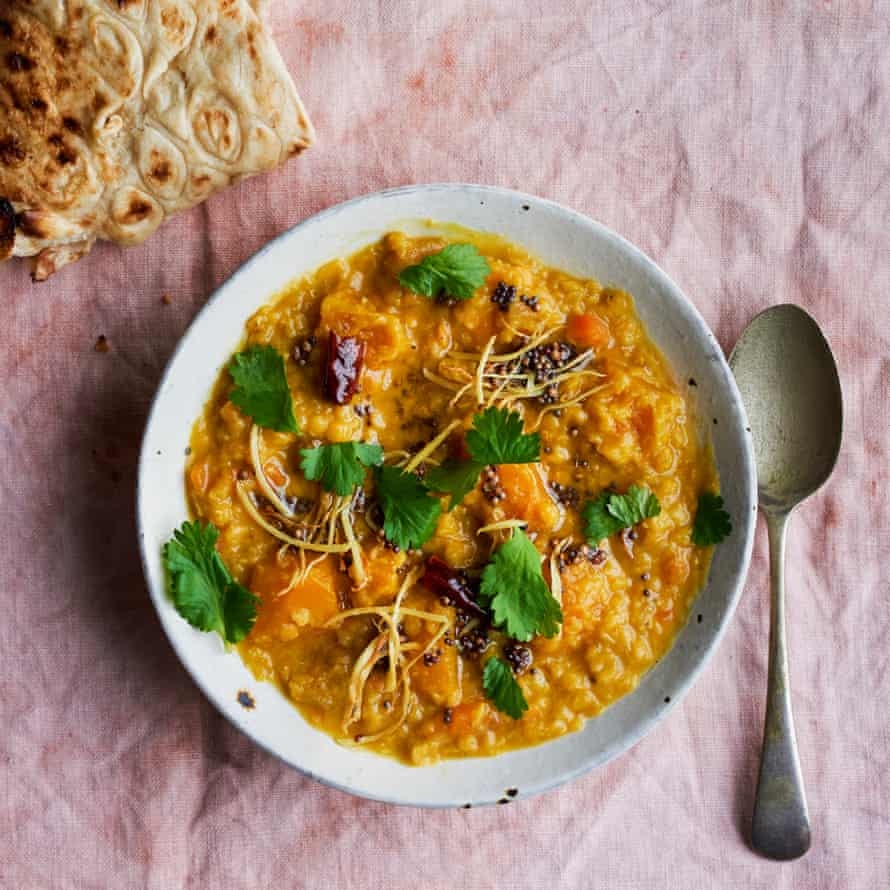
Ingredients
210g red lentils
3 tbsp coconut oil
150g onion, cut into half moons
100g carrots, finely diced
200-300g pumpkin, peeled and diced into 2cm pieces
½ tsp ground turmeric
½ teaspoon ground red chilli powder
1 teaspoon salt
2 tablespoon fresh lime or lemon juice
2 teaspoon coriander seeds, crushed
2 teaspoon black or brown mustard seeds
5cm piece fresh ginger, peeled and cut into matchsticks
1 Kashmiri red chilli
10g chopped fresh coriander leaves
Preparation
Clean the lentils for any debris, rinse under cold running water, then put in a bowl, cover with 500ml cold water and set aside.
Heat a tablespoon of the oil over medium-high heat in a medium saucepan. Add the onions, and saute until they turn translucent – three to four minutes. Add the carrots and pumpkin, and saute until tender – about eight minutes. Stir in the turmeric and red chilli powder, and cook for a further minute.
Add the lentils and their soaking water to the vegetables, stir in a teaspoon of salt and bring to a rolling boil over a medium-high heat. Reduce the heat to low, cover and leave to simmer until the vegetables are completely tender and cooked – about 20 minutes. Remove from the heat, stir in the lime juice, taste and season with salt as needed.
Heat the remaining coconut oil in a small saucepan over a medium heat. When the oil is hot, add the coriander and mustard seeds, and cook until the seeds start to pop. Add the ginger to the hot oil, cover the pan with a lid and swirl for 30 seconds, until the mustard seeds stop sputtering.
Break the Kashmiri chilli in half and toss it into the hot oil. Remove from the heat and swirl the contents of the saucepan for another 30 seconds, until the chilli turns crisp. Pour this hot mixture over the lentils. Garnish with the fresh coriander leaves and serve warm with buttered flatbread or plain rice.
Recipe adapted from Nik Sharma, Guardian 31 Oct. 2020.
Rebecca’s Recipe of the Week: Pasta with Creamy Carrot Miso Sauce
Another very good recipe from Slyvia Fontaine. The creamy carrot sauce colours the pasta a beautiful gold, while the fresh, herby gremolata adds vibrant green. Toasted breadcrumbs provide a contrasting crunch against the richness of the sauce. You would certainly not guess that this is vegan, but you’ll see right away how beautiful it looks in your bowl. The flavours work really well together and I recommend this highly.
Pasta with Creamy Carrot Miso Sauce
Serves 4
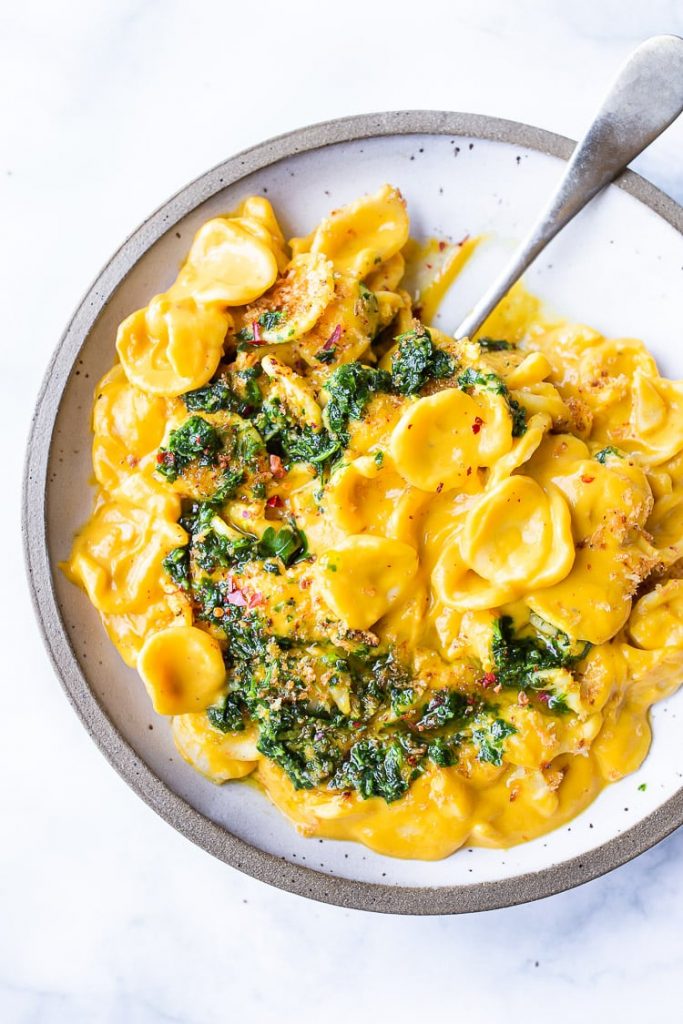
Ingredients
Carrot Miso Sauce
2 shallots, rough chopped (or 1/2 an onion)
3 large garlic cloves, rough chopped
2 tablespoons olive oil
150g carrots
450ml water
40g cashews
Freshly-ground pepper
3 tablespoons white miso paste
Gremolata
60g fresh coriander or parsley (Sylvia notes you can also use carrot tops)
1 tablespoon lemon zest ( zest from one medium lemon)
¼ teaspoon salt
1 fat garlic clove
70-100ml olive oil
Toasted Breadcrumbs
1 thick slice of good bread, grated, to make about 50g breadcrumbs
250g pasta (Sylvia Fontaine recommends orecchiette)
Instructions
Cook the sauce: Heat oil in a medium pot, over medium heat. Saute shallot and garlic until fragrant and golden, about 5 minutes, stirring often. Add carrots, cashews, water, and pepper and bring to a boil. Cover, lower heat to low and simmer gently until carrots are fork-tender, about 15 minutes. Stir in the 3 tablespoons of miso and let cool for 5-10 minutes.
While the carrots simmer make the Gremolata: Place coriander or parsley, lemon zest, salt and garlic in a food processer and pulse repeatedly until finely chopped. Add 70ml oil, pulsing a few more times until incorporated (but not too smooth). Add more oil if you prefer a looser version.
Now make the breadcrumbs: place the breadcrumbs in a frying pan over medium heat and toast, stirring frequently, until the crumbs are golden brown. Set aside.
Bring some water to the boil, and cook the pasta according to the packet instructions.
While the pasta is cooking blend the sauce: place the carrot-cashew sauce in a high-speed blender or food processor and blend on the lowest setting, gradually increasing speed, until fully blended, creamy and silky smooth, which will take between one and two minutes. Slyvia writes: ‘Take your time here and get it SMOOTH!!!’
Drain the pasta and pour the sauce over. Heat it gently if needed. Taste and adjust salt.
Divide among bowls, and sprinkle with toasted bread crumbs and spoon the gremolata over top. Enjoy with a glass of chardonnay.
Recipe adapted from Sylvia Fontaine, Feasting at Home
Rob’s Recipe of the Week: Fast (and veggie) Bourguignon
You’ll have to nip to the shops for some mushrooms but otherwise, put with mash and greens, this recipe makes good use of lots of this week’s share. I’ve never made bourguignon so I’m looking forward to it!
Mushroom bourguignon
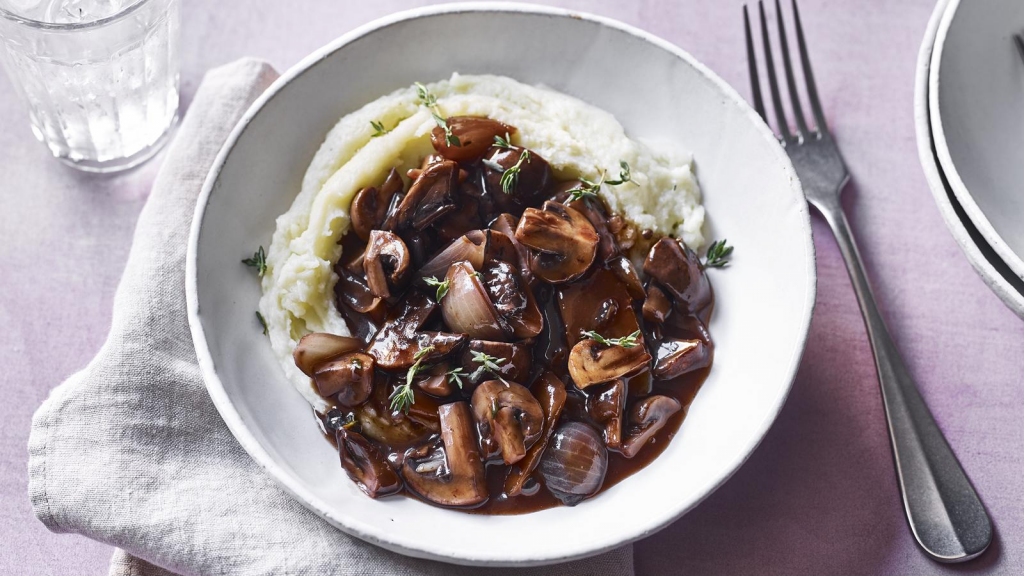
Ingredients
1½ tsp olive oil
3 shallots, peeled, quartered and layers separated
1 large carrot, peeled and cut into slices on an angle
100g/3½oz button mushrooms, quartered
50g/1¾oz chestnut mushrooms, quartered
3 Portobello mushrooms, roughly chopped
7 fresh thyme sprigs, leaves only, or 1½ tsp dried thyme
3 garlic cloves, finely chopped
150ml/¼ pint fruity vegan red wine
200ml/7fl oz vegetable stock
2 bay leaves
1 tbsp tomato purée
1 tsp yeast extract
1 tbsp cornflour, or plain flour
salt and freshly ground black pepper
Method
Heat the oil in a heavy-based saucepan over a medium heat. Add the shallots and carrot and fry gently for 5 minutes.
Add all the mushrooms and most of the thyme and cook for 5–6 minutes (note, an alternative is to dry fry the mushrooms before the other ingredients – they cook in their own juices, enhancing the flavour). Add the garlic and fry for a further minute.
Add the wine and bring to the boil. Simmer for 2 minutes, then turn the heat down and add the stock, bay leaves, tomato purée and yeast extract and stir. Sift in the cornflour and ½ teaspoon salt and whisk in well.
Cook for 7–8 minutes, then season with salt and pepper and add the rest of the thyme if preferred.
Serve with creamy mashed potatoes or a crunchy slice of crusty bread.
Taken from: BBC Good Food
Rebecca’s Recipe of the Week: Crushed Carrots
This is a spectacular recipe: the combination of carrots, harissa, and lemony yoghurt is inexplicably delicious. It looks particularly lovely served on a blue plate, and makes an ideal accompaniment to another Ottolenghi showstopper: his warm lentils with tahini.
Crushed Carrots with Harissa and Nuts
Serves 4
Ingredients
1 tablespoon olive oil, plus extra to finish
1 tablespoon butter
1kg carrots, peeled and sliced 2cm chunks
200ml water
grated zest of 1 orange
1 clove garlic, crushed
2 teaspoons harissa paste, or to taste
grated zest of 1 lemon divided into two portions
1 tablespoon lemon juice
150g Greek yogurt
25g shelled unsalted pistachios or cashews, coarsely chopped
Salt and black pepper
Instructions
Place the olive oil and butter in a sauté pan over medium-high heat. Add the carrots and sauté for 6 minutes, stirring often, until they’re soft and take on colour. Add the water, reduce the heat to medium-low, cover the pan, and cook for another 25 minutes, until carrots are completely soft and perhaps a little caramelised, and there is hardly any liquid left.
Transfer the carrots to a food processor, add 3⁄4 teaspoon salt, and blitz to form a coarse paste. Leave to cool, then add orange zest, garlic, harissa, one portion of the lemon zest and the black pepper to taste. Stir to combine.
Mix the yogurt, lemon juice, remaining lemon zest, and 1⁄4 teaspoon salt.
Spread the yogurt mixture on a blue serving platter and spoon the carrots on top. Sprinkle with nuts, drizzle with a little olive oil, and serve.
Recipe adapted from Yotam Ottolenghi, Plenty More (2014).
Rebecca’s Recipe of the Week: A Very Elaborate Borscht
In case you have a little time on your hands just now, here is an excellent use of a few hours. The result is the best borscht I, at least, have ever tasted. Alissa Timoshkina, whose recipe this is, notes that if you can make the broth 24 hours in advance, ‘you will be rewarded with an even better tasting soup, but a few hours of resting will also do the trick’.
For the red cabbage sauerkraut, I recommend you get in touch with Canalside member Erica Moody, who makes superb sauerkrauts of all sorts.
Borscht
Serves 4
Ingredients
unrefined sunflower oil, for frying and roasting
1 large onion, finely diced
1 carrot, peeled and grated
6 raw beetroots
2 red peppers
2 tablespoons tomato purée
2 litres cold water
2 bay leaves
1 tablespoon black peppercorns
1 tablespoon coriander seeds
1 tablespoon fennel seeds
4 garlic cloves, peeled
bunch of dill
small bunch of flat leaf parsley
2 garlic cloves, grated
500g red cabbage sauerkraut
2 tablespoons pomegranate molasses
1 red onion
1 tablespoon brown sugar
400g can red kidney beans
2 teaspoons smoked paprika
4 tablespoons soured cream
salt
Preparation
Heat up a tablespoon of sunflower oil in a large pan and fry the onion and carrot for about 8 minutes until golden. Meanwhile, peel and grate 2 of the beetroots and core, deseed and thinly slice 1 red pepper. Add the vegetables to the pan together with the tomato purée and a splash of water. Season with salt to taste and fry for a further 5–8 minutes.
Top with the measured cold water, add the bay leaves along with the peppercorns and all the seeds, whole garlic cloves and half the bunches of dill and parsley. Season with a tablespoon of salt and bring to the boil. Reduce the heat, add the grated garlic and half the sauerkraut with its brine and simmer, covered, over a low heat for 40 minutes–1 hour.
Turn off the heat and let the borscht rest for another hour, while you prepare the rest of the elements.
So far, so good, but here is where the recipe starts to deviate from the norm quite a lot: to prepare the vegetables that will grace the plate and also add extra flavour and texture to the soup, you will need to do a bit of roasting.
Start by preheating the oven to 160°C fan/Gas Mark 4. Peel the remaining 4 beetroots, cut into wedges and dress with oil, salt and the pomegranate molasses. Peel the red onion, cut into wedges and season with salt and the brown sugar to bring out their sweetness and promote caramelization. Place on a roasting tray with the beetroot and roast together for 30 minutes. Drain the kidney beans, then dress them with salt, oil and the smoked paprika. Core and deseed the remaining red pepper, then cut into thin strips and dress with salt and oil. Roast the beans and pepper together, as they will need only 10–15 minutes.
When ready to serve, strain the broth through a sieve or a muslin cloth, discarding the solids. All we need is that rich broth! Reheat again if necessary. Next, create layers of texture and flavour in each bowl by adding a heaped tablespoon of the remaining sauerkraut to each, as well as a handful of roasted beetroot, onion, kidney beans and red pepper. Top each bowl with the hot broth and add a dollop of soured cream and a generous sprinkle of the remaining dill and parsley, chopped. The intensity of the flavours and textures of this dish is beyond words, while the look of the bowl will seduce the eye without a doubt.
Recipe from Alissa Timoshkina, Salt & Time: Recipes from a Russian Kitchen (2019).
Rob’s Recipe of the Week: Onion Glut Soup
Last winter was my first at Canalside and followed an extremely hot and dry summer (with a poor onion harvest as a result of the dry conditions) which means I’ve been quite shocked at the number of onions in my share this winter – so much so that I have quite the pile accumulating at home. What better way is there to get through them than onion soup? The recipe is from another good youtube chef Binging with Babish (and is featured in Netflix’s The Chef Show S2E6) – see if you can spot his catchphrase “Let the flavours get to know each other” (although they have to do that a lot with onion soup!). I doubt beef stock is essential in this recipe so adapt it for a veggie/vegan diet as required.
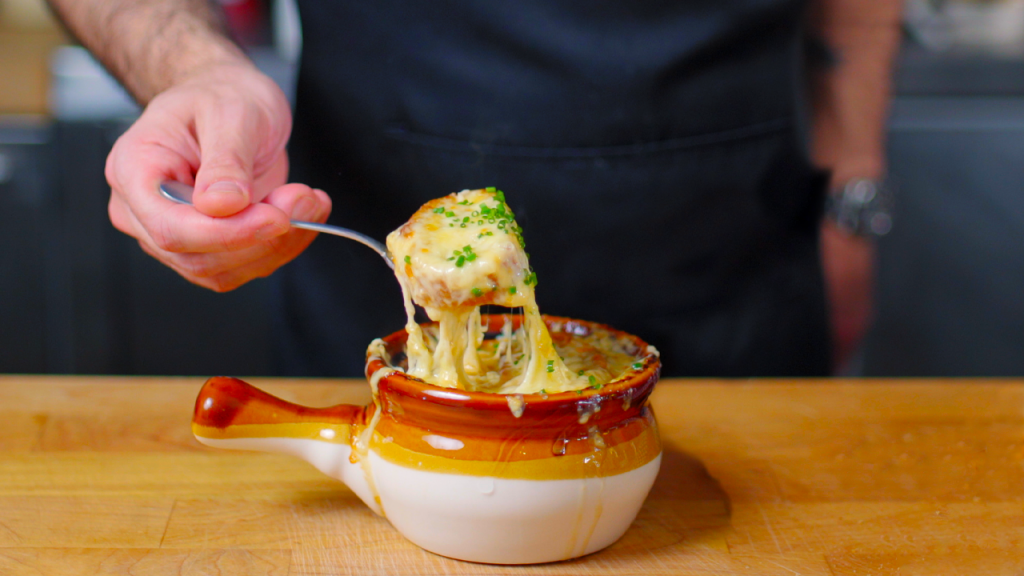
Shopping List
For the soup:
1350g Onions (yields 4 servings)
6 cups high quality beef stock (or amped up store bought stock, see below) (or veggie stock)
2 Tbsp flour
Soy sauce (optional)
Fish sauce (optional)
Day old French baguette (for topping)
Gruyere cheese, shredded (for topping)
For Amped-Up Store Bought Stock
1 bunch parsley
Sliced carrots
Thyme sprigs
3 garlic cloves, halved
2 bay leaves
Sprinkle of peppercorns
2 cloves (optional)
Parmesan cheese rind
Method
Start by preparing your onions. Peel them and then cut in half from pole to pole – through the root and stem. Remove the tough root part by cutting it away with your knife. Then thinly slice them pole to pole – like cutting with the grain of the onion. This gives the slices more structural integrity so that they stand up to the slow cooking method.
Next prepare your stock. Ideally you would use homemade beef stock, but you can also “soup” up a store bought version. To do that, add your beef broth to a stock pot and bring to a simmer. Add aromatics like parsley, sliced carrots, thyme sprigs, garlic, bay leaves, peppercorns, cloves, and parmesan rind. Let it simmer for 1 hour.
In a large dutch oven (any large thick based pan) drizzle 2-4 Tbsp olive oil and let heat up for one minute. Dump in the sliced onions. It will look like way too many, but just trust me.
Slowly caramelize the onions over medium heat. Keep them moving constantly, and scrape down the sides of the pot. The onions are done when they are soft, jammy, and caramelized with a lot of fond on the bottom of the pot.
Add 2 Tbsp flour to the onions and cook for 1-2 minutes then deglaze the pot with 1 cup of dry sherry and cook, scraping up fond from the bottom of the pot.
Once the alcohol is cooked off, add the beef broth. Make sure to strain it first if you added aromatics.
Let the whole thing simmer for 5-10 minutes to let the flavors get to know each other. Optional: add umami boosters. I like to add a splash of fish sauce and soy sauce to richen the flavors.
Cut thick slices of day-old french baguette. Put them on a baking sheet. Drizzle with olive oil and top with salt and pepper. Toast bread in a 200°C oven for 5 minutes. Slice a clove of garlic in half and rub down each piece of bread with the garlic.
Check the soup for salt and pepper and season as necessary. Ladle soup into broiler-safe cups. Top with sliced baguette and shredded cheese. Put the bowls onto a baking sheet and put into an oven preheated to broil. Broil for 3-5 minutes until golden brown.
Garnish with chives and serve and enjoy!
From https://basicswithbabish.co/basicsepisodes/frenchonionsoup
Rebecca’s Recipe of the Week: Meera Sodha’s Roasted Carrot and Cabbage with Korean Chile Paste
Gochujang, Korean chile paste, is warm and flavourful without being mouth-numbing. It adds a richness and complexity to roasted carrots and cabbage. The proportions of the two vegetables is not terribly important, and you might even want a bit more of the gochujang-cumin-ginger mixture. You could serve this with almost anything, from roast chicken to a potato pancake. It’s nice topped with yoghurt, too.
Roasted Carrot and Cabbage with Gochujang
Serves 2-4 as a side dish
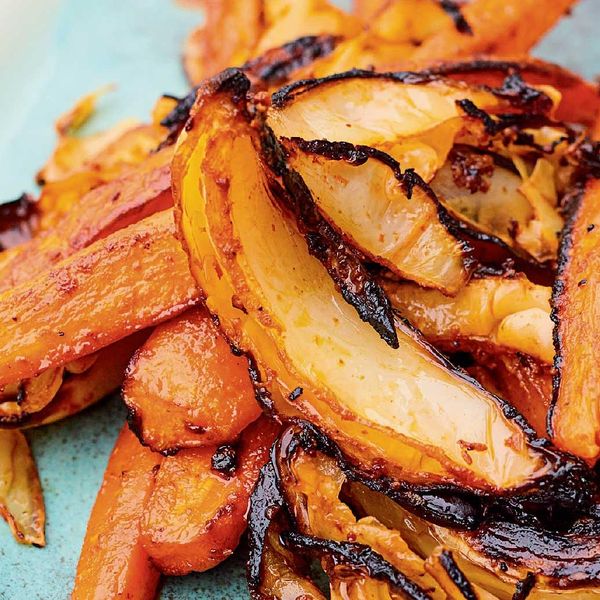
Ingredients
750g carrots, peeled
750g white cabbage
3 tablespoons rapeseed oil
1.5 tablespoons gochujang paste
1 teaspoon ground cumin
1 teaspoon salt
4 cloves garlic, peeled and grated
3cm fresh ginger, peeled and grated
2 tablespoons more rapeseed oil
1 tablespoon white vinegar (I used rice wine vinegar; the original recipe calls for white wine vinegar)
Preparation
Preheat the oven to 220C. You will need two large baking trays and Meera Sodha recommends lining them with foil.
Cut the carrots lengthwise in half or quarters (depending on the size) to make long batons. Cut the cabbage into 2cm wedges. Place them in a large mixing bowl, or directly onto your two baking trays.
In a small bowl, mix the 3 tablespoons oil, gochujang, cumin, salt, garlic, and ginger. Pour over the vegetables and mix with your hands so that the marinade gets everywhere.
Spread the vegetables across the two trays. Make sure the carrots and cabbage are in a single layer, then bake for 35 to 40 minutes, until the vegetables are tender and blackened at the edges.
Meanwhile, put 2 tablespoons of oil and the vinegar into a large serving bowl. When the carrots and cabbage are roasted, transfer them to the bowl while still hot and toss them in the oil and vinegar and serve.
Recipe adapted from Meera Sodha, East (2019).